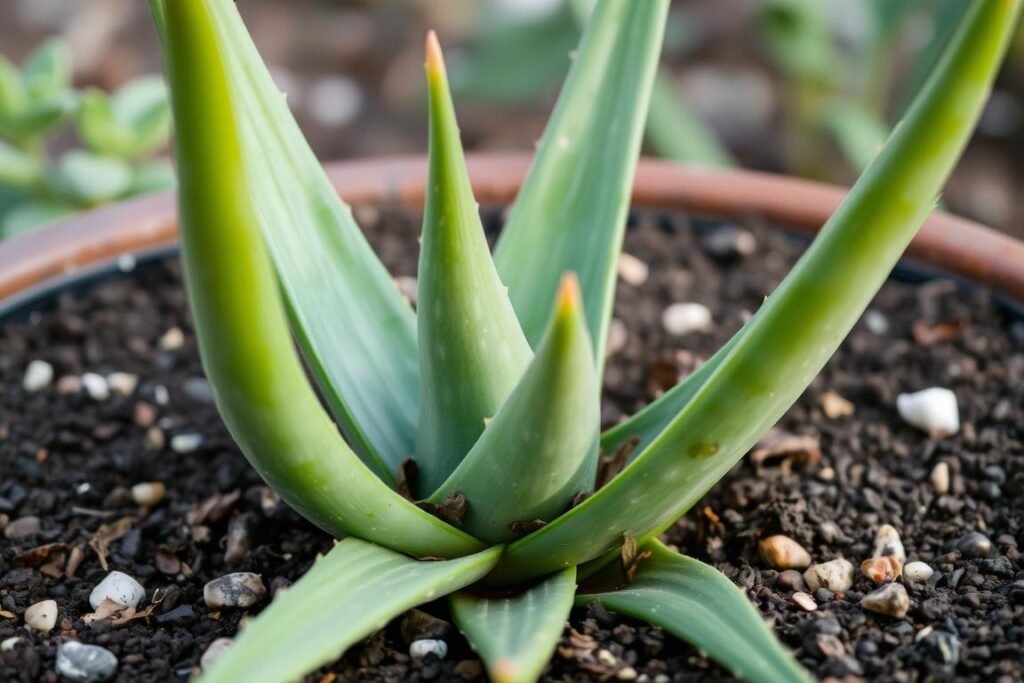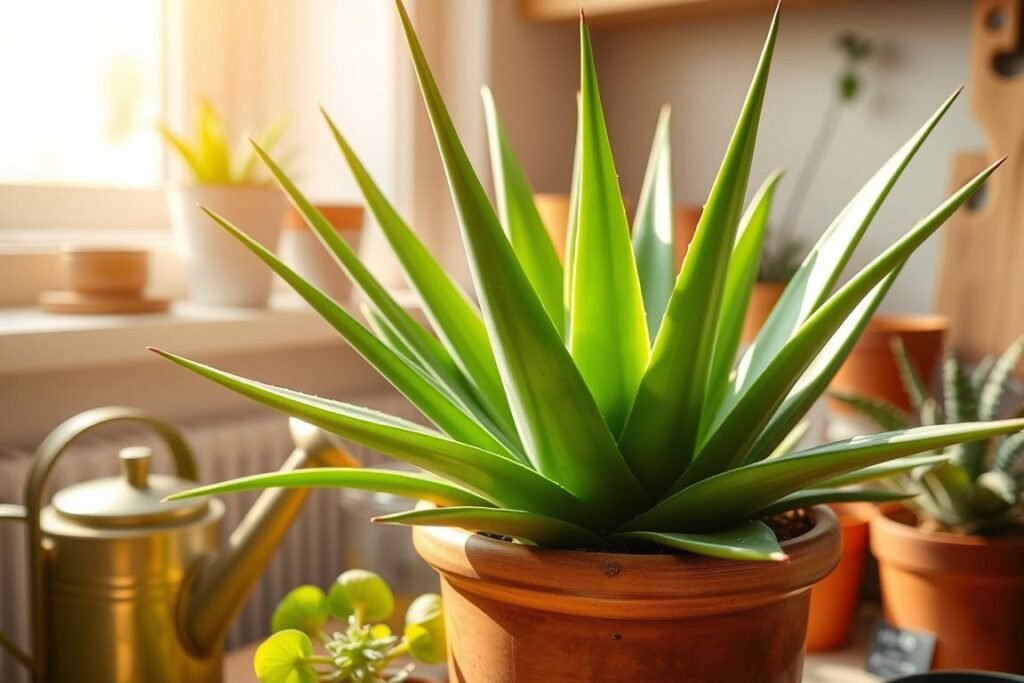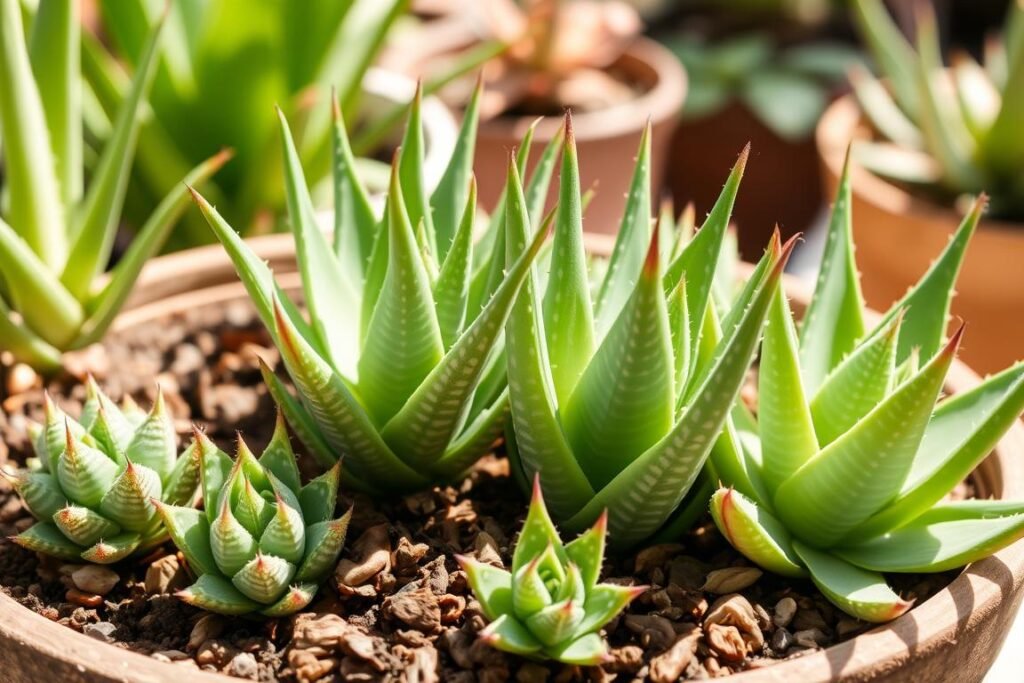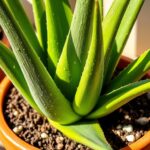I love aloe vera plants a lot. They need the right care to stay healthy. Knowing when to repot them is very important.
In this guide, I’ll tell you the best time to repot your aloe vera. I’ll use my own experiences and the latest research.

Key Takeaways
- Aloe vera plants need repotting every 2-3 years to stay healthy and grow.
- Spring is the best time to repot them, matching their natural growth cycle.
- Signs they need repotting include roots growing out, slow growth, and bad soil.
- Repotting helps with root growth, better nutrient absorption, and might make them flower.
- Choose a pot only a bit bigger than the old one to avoid water problems.
Understanding Your Aloe Vera Plant’s Growth Cycle
The aloe vera grows in a special way. It changes with the seasons. Knowing this helps you care for it better.
Natural Growth Patterns
Aloe vera plants grow slowly. They form leaves that can be 30-40 cm long. These leaves grow bigger over time.
After three years, they might bloom. They grow tall stalks with small, bell-shaped flowers.
Seasonal Changes Impact
The seasons affect how aloe vera grows. In spring and summer, it grows more. New leaves and roots appear.
In fall and winter, it grows less. It’s more quiet during these times.
Growth Indicators to Watch
- New leaf formation: Look for fresh, green leaves. This means the plant is growing well.
- Root development: Check the roots. If they grow a lot, it might be time to repot or divide.
- Potential flowering: Older plants might bloom. This is a special sight for plant lovers.
Knowing how aloe vera grows helps you care for it. This way, it stays healthy and strong.
Signs Your Aloe Vera Needs Repotting
As an avid aloe vera enthusiast, I’ve learned that recognizing the signs your plant needs repotting is crucial for its long-term health and vitality. Aloe vera plants are generally resilient but need repotting to grow. Let’s explore the telltale signs that indicate it’s time to provide your aloe vera with a fresh home.
One of the most obvious signs is overcrowded roots. When the roots start emerging from the drainage holes or the plant appears to be sitting too high in the pot, it’s a clear indication that the root system has outgrown its current container. Aloe vera plants thrive when they have ample room to spread their roots and access the necessary nutrients and moisture.
Another sign to watch for is stunted growth. If your aloe vera’s leaves are no longer expanding at the usual rate or if the plant appears to have reached a growth plateau, it may be a sign that the roots are becoming constricted. This can lead to nutrient deficiencies and an overall decline in the plant’s vigor.
Yellowing leaves can also indicate that your aloe vera is in need of a larger home. This nutrient deficiency can occur when the plant’s root system is unable to effectively absorb and distribute the necessary nutrients throughout the leaves. Addressing this issue by repotting can help restore the plant’s vibrant, healthy appearance.
Lastly, if you notice that your aloe vera’s soil takes an unusually long time to dry out or that the plant is no longer retaining water as effectively, it could be a sign that the roots have become oversaturated and the plant is struggling to thrive. Repotting can help alleviate this issue and provide your aloe vera with the well-draining environment it craves.
By keeping a close eye on these signs, you can ensure your aloe vera plant continues to flourish and reaches its full potential. Timely repotting is a crucial aspect of aloe vera care, and attending to these needs can help your plant thrive for years to come.
When is the best time of year to repot an aloe vera plant
Spring is the best time to repot your aloe vera plant. This succulent loves consistent care. Spring’s warm weather and sunlight are perfect for it to grow well.
Spring Benefits for Repotting
When your aloe vera comes out of winter sleep, spring is the best time. The warm weather and more sunlight help it grow fast. This way, it can get used to its new home before summer gets too hot.
Summer Considerations
Repotting in summer needs extra care. The heat and sun can make the plant sick. If you repot in summer, make sure it gets shade and keep the soil moist until it recovers.
Avoiding Winter Repotting
Don’t repot your aloe vera in winter. It’s sleeping and can’t handle the shock of being moved. Wait for spring when it’s growing to repot it safely.
Remember, your climate and growing conditions might change when to repot. Knowing your aloe vera’s needs helps it stay healthy for a long time.
Essential Tools and Materials for Repotting
When it’s time to repot your aloe vera plant, having the right tools and materials is key. A few important items will help your aloe thrive in its new home. Let’s look at what you’ll need for this task.
- A new pot with drainage holes – Aloe vera plants need soil that drains well, so a pot with holes is important.
- Well-draining potting soil for succulents – Aloe vera plants do best in soil made for cacti and succulents. It should drain well and have the right nutrients.
- Pruning shears or sharp scissors – You might need to cut any damaged or dead roots before repotting.
- Gardening gloves – These will protect your hands while you handle the aloe plant and soil.
- A repotting mat or newspaper – This keeps your work area clean and tidy while you repot.
Get all these repotting tools, succulent potting materials, and aloe vera care supplies ready before you start. Having everything ready makes the task easier and faster.
“Proper preparation is key to a successful repotting experience. Take the time to gather all the necessary tools and materials before you start.”
With the right tools, you can carefully move the aloe plant to its new pot. Remember, a well-prepared workspace and the right repotting tools, succulent potting materials, and aloe vera care supplies will help you succeed.
Selecting the Perfect Pot Size and Type
Choosing the right pot for your aloe vera is key. It affects its growth and health. Think about what will make your aloe vera happy in its new home.
Material Considerations
Aloe vera likes containers that breathe and drain well. Terracotta and ceramic pots are great. They are strong and let air reach the roots. Plastic pots hold too much water, which is bad for your plant.
Drainage Requirements
Drainage is very important for aloe vera. It can get root rot if the soil is too wet. Make sure your pot has big holes at the bottom. This lets water out and keeps your plant healthy.
Size Guidelines
Choose a pot that’s 1-2 inches wider than your plant’s current one. This gives the roots room to grow. Aloe vera likes shallow, wide pots. As it grows, you can get a slightly bigger pot every time.
Think about the pot’s material, drainage, and size. This will help your aloe vera thrive. The right pot will make your aloe vera happy and healthy.
Ideal Soil Mix for Aloe Vera
Choosing the right soil mix is key for your aloe vera plant. Aloe plants love a mix that drains well and holds some moisture. The best mix is one part potting soil to one part coarse sand or perlite.
This mix keeps your aloe’s roots dry. It stops water from pooling, which can harm your plant. Cactus mix or succulent soil are also great for aloe vera.
To make your own mix, combine compost, sand, rock powder, and expanded clay. This mix drains well and gives your aloe the nutrients it needs. But, avoid mixes that hold too much water.
“Aloe vera plants thrive in well-draining soil and do not tolerate excess water.”
When you repot your aloe, pick a container with lots of holes. Terra cotta or clay pots are best. They let air in and help water evaporate. With the right well-draining potting soil and a good pot, your aloe will grow strong and healthy.

Step-by-Step Repotting Process
Repotting your aloe vera plant is very important. It keeps the plant healthy and helps it grow well. Here’s how to repot your succulent step by step.
Preparation Steps
Water your aloe vera plant 3-5 days before you repot it. This makes the plant ready for the change. Then, get your tools: a new pot, potting mix, and gardening tools.
Removal Techniques
Take the aloe vera plant out of its pot carefully. Shake off old soil from the roots. Don’t hurt them. Cut off any dead or damaged roots with sharp shears.
Planting Methods
Put a layer of fresh potting mix at the bottom of the new pot. Place the aloe vera plant in the middle. Fill the sides with more soil. Press the soil gently but not too hard. Water the plant a little to help it settle.
By following these steps, you’ll repot your aloe vera plant right. This will help it stay healthy and grow well. Remember, timing, soil, and care are important for a happy aloe vera plant.
Post-Repotting Care Instructions
Caring for your aloe vera plant after repotting is very important. It helps the plant grow well. There are a few steps to follow to make sure your aloe vera does great.
First, put your aloe vera in a shaded area for a week. This keeps it from getting sunburned. Also, water it a little, letting the top inch of soil dry before watering again.
- Watch your aloe vera for signs of stress, like wilting or color changes.
- Slowly start giving it more light and food over a few weeks.
By following these aloe vera aftercare tips, you can make sure your repotted plant maintenance goes well. Remember, being patient and watching your aloe vera’s needs is key for the best succulent care tips.
| Aloe Vera Aftercare Checklist |
|---|
| Place in shaded area for 1 week Water sparingly, allowing top inch of soil to dry between waterings Monitor for signs of stress (wilting, discoloration) Gradually reintroduce to normal light and fertilization over 2-4 weeks |

Common Repotting Mistakes to Avoid
Repotting your aloe vera plant is a careful task. It’s key to avoid mistakes that can hurt your succulent. As someone who loves plants, I know how important it is to care for your aloe vera during repotting.
Watering Errors
One big mistake is overwatering your aloe vera. After moving it, it’s easy for the plant to get root rot. Wait a few weeks before watering it like usual. This lets the roots settle in the new soil.
Don’t underwater your plant either. Finding the right water balance is important.
Pot Size Issues
Choosing the right pot size is very important. A pot that’s too big can hold too much water. This can hurt the roots. Pick a pot that’s only 20% bigger than the old one.
This size gives the plant room to grow without stressing the roots.
Soil Problems
Using the wrong soil can also cause problems. Aloe vera needs soil that drains well to avoid root rot. Don’t use heavy potting mixes. Instead, choose soil made for cacti and succulents.
Adding perlite or sand can help the soil drain better.
By avoiding these common mistakes, you can help your aloe vera plant do well after repotting. With the right care, your plant will stay healthy and beautiful for a long time.
Dealing with Aloe Vera Pups During Repotting
Aloe vera plants can grow new plants from their base. These are called “pups.” When you repot your aloe vera, you can separate these pups. This is a great way to grow more plants.
When you repot your aloe vera, look for pups that are 5 centimeters (2 inches) long. Carefully take them off the mother plant. Make sure they have roots. This helps them grow well on their own.
- Look for pups that have several sets of leaves and a sturdy root system.
- Gently twist or cut the pups away from the mother plant, taking care not to damage the roots.
- Allow the separated pups to dry for a day before planting them in their own pots filled with well-draining soil.
By growing pups, you can share your aloe vera with others. It’s a fun way to spread the joy of these plants. Caring for the pups during repotting helps them grow strong.

Aloe vera plants are easy to care for. They even do well when you forget to water them. So, don’t worry if you mess up a little. With a bit of effort, you can grow a whole garden from just one plant.
Troubleshooting After Repotting
Repotting an aloe vera plant can sometimes lead to unexpected challenges. But don’t worry, with a little troubleshooting, you can get your succulent back on track. Let’s explore some common post-repotting issues and how to address them.
Identifying Transplant Shock
One of the most common problems after repotting an aloe vera is transplant shock. This shows up as leaf drooping, discoloration, or wilting. If you notice these signs, the plant may be struggling to adjust to its new environment.
- Ensure the plant is not getting too much direct sunlight, which can exacerbate transplant stress.
- Check that the soil is not overly wet, as overwatering can also contribute to transplant shock.
Tackling Leaf Issues
Yellowing leaves could indicate overwatering, while brown, crispy leaves may be a sign of underwatering or too much sun exposure. Carefully monitor the plant’s moisture levels and adjust your watering and light exposure.
| Leaf Issue | Possible Cause | Solution |
|---|---|---|
| Yellowing leaves | Overwatering | Reduce watering frequency |
| Brown, crispy leaves | Underwatering or too much sun | Increase watering or move to a shadier spot |
By addressing these common repotted plant problems and aloe vera care issues, you can help your succulent transplant recovery. This will get your aloe vera thriving again.
“With a little patience and the right adjustments, your aloe vera should bounce back from the repotting process.”
Conclusion
Repotting aloe vera plants is very important. It helps them stay healthy and grow well. Knowing when and how to repot is key.
Choosing the right soil and pot is also important. This helps your aloe vera plant grow strong. It can even bloom beautiful flowers.
Aloe vera plants are easy to care for. They are great for beginners and experts alike. With the right care, they can thrive indoors.
By following the tips in this article, you can help your aloe vera plant grow. It will make your home look nice and be useful too.
Improving aloe vera care is all about listening to your plant. Watch for signs it needs help. Then, take action to keep it happy and healthy.
FAQ
When is the best time of year to repot an aloe vera plant?
Spring is the best time to repot an aloe vera plant. It’s when the plant grows the most. This helps it adjust well to a new pot.
What are the signs that an aloe vera plant needs repotting?
If the roots show through the holes, or if the plant stops growing, it’s time to repot. Also, if it holds less water or stops growing, it needs a bigger pot.
Can I repot an aloe vera plant in the summer?
Yes, but be careful in summer. The plant might get stressed from the heat. Keep it in partial shade after repotting.
What are the essential tools and materials needed for repotting an aloe vera plant?
You’ll need a new pot, soil mix, pruning shears, gloves, and a mat to keep things clean.
How do I choose the right pot size for my aloe vera plant?
Pick a pot that’s 1-2 inches bigger than the current one. Aloe vera likes a shallow, wide pot for its roots.
What type of soil is best for repotting an aloe vera plant?
Use a mix of one part potting soil and one part sand or perlite. This mix drains well and keeps the roots healthy.
How do I properly repot an aloe vera plant?
Carefully remove the plant from its pot. Shake off old soil and trim bad roots. Put new soil in the pot, place the aloe vera, and fill with soil. Water a little after to help it settle.
What should I do after repotting an aloe vera plant?
Keep it in the shade for a week to avoid sunburn. Water only when the top inch of soil is dry. Watch for stress signs and slowly get back to normal care.
Can I propagate my aloe vera plant during repotting?
Yes, you can propagate during repotting. Remove and pot the offsets or “pups” in well-draining soil.






